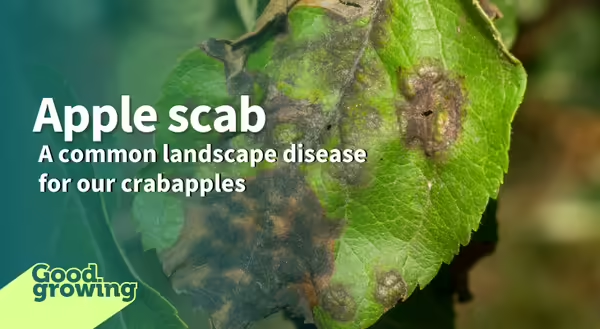
The problem with many plant diseases is once you notice them it’s often too late. That’s especially true with our trees. We often don’t gaze at the canopies of our trees looking for problems. The typical homeowner won’t notice disease or insect damage until visible symptoms surpass 10 percent of the canopy. One tree disease that seems to sneak up on us every year is apple scab.
Many who grow apples or crabapples (Malus spp.) have likely seen this disease before and may or may not know it. Apple scab is so common that plant pathologists expect to see it every year. In 2023, our spring started mild, turned hot, and then cooled down for several weeks. The prolonged cool weather is a good indicator of stronger apple scab pressure on our crabapples and apple trees.
Apple scab (Venturia inaequalis) is a fungus that infects apples, crabapples, mountain ash, pear, and Cotoneaster. Symptoms typically start on the underside of leaves, forming light brown to olive green lesions that are irregularly shaped. As the infection progresses the lesions become more circular with the spots eventually turning black or brown. Infected tissue will thicken creating a bulge on the upper leaf surface. Leaves may curl and scorch at the margins. Apple scab can progress to the leaf petioles and fruit pedicels, causing early leaf and fruit drop. As the canopy becomes sparse in mid-to-late summer that’s often when homeowners take notice. Unfortunately, by that time it is too late to treat the tree.
While not generally fatal to an infected tree, there are some options for dealing with apple scab.
- Plant resistant varieties. This is the most desirable means of managing apple scab in the landscape. Keep in mind during excessively wet years even resistant varieties may show signs of this disease.
- Keep the area beneath the tree clear of infected leaf residue. Removing fallen leaves can be beneficial. Note that apple scab is so common and disperses so easily that infection is likely to reoccur. In apple orchards simply mowing the fallen leaves has been shown to reduce the following years severity of apple scab.
- Promote a healthy tree. Mulch with arborist wood chips and water the tree in times of drought.
- Use preventative fungicide sprays. Fungicides labeled for apple scab control include mancozeb, chlorothalonil, calcium polysulfide, copper sulfate, or potassium bicarbonate. Read and follow all label directions. Most of these sprays are preventatives, not curatives. So you will need to spray before the fungus occurs. Don’t waste money spraying infected leaves!
Once the leaves start to yellow and drop it is too late to protect the tree. If all this fungicide spraying sounds like a chore, but a defoliated tree in August is an eyesore in your landscape, you may need to prune horizontally at the soil line thusly removing the tree and replanting with a resistant variety. Following are resistant crabapple cultivars:
- 'Adams'
- 'Adirondack'
- 'Baskatong'
- 'Bob White'
- 'Candymint'
- Coralburst®
- Christmas Holly™
- 'David'
- 'Donald Wyman'
- Firebird®
- Harvest Gold®
- 'Indian Magic'
- 'Indian Summer'
- 'Jewelberry'
- Lollipop®
- 'Louisa'
- Molten Lava™
- M. floribunda
- M. halliana var. parkmanii
- 'Prairie Maid'
- 'Prairiefire'
- 'Purple Prince'
- Red Jewel™
- 'Robinson'
- 'Royal Beauty'
- 'Tina'
- 'Sargent'
- 'Silver Moon'
- 'Strawberry Parfait'
- Malus x zumi
- 'Calocarpa'
Source for apple scab resistant crabapple University of Minnesota Extension
Good Growing Tip of the Week: Fungicide applications for apple scab start as the leaves emerge from their buds and continue until 2 weeks after flower petal fall. Follow fungicide label directions for reapplication intervals. Avoid multi-purpose tree fruit sprays as these contain insecticides that will kill pollinators visiting your crabapple’s flowers.
Sign up for our emails! Want to get notified when new Good Growing posts are available? SIGN ME UP
MEET THE AUTHOR
Chris Enroth is a horticulture educator with University of Illinois Extension, serving Henderson, McDonough, Knox, and Warren counties since 2012. Chris provides horticulture programming with an emphasis on the home gardener, landscape maintenance personnel, and commercial landscapers. Additional responsibilities include coordinating local county Master Gardener and Master Naturalist volunteers - providing their training, continuing education, advanced training, seasonal events, and organizing community outreach programs for horticulture and conservation assistance/education. In his spare time, Chris enjoys the outdoors, lounging in the garden among the flowers (weeds to most).